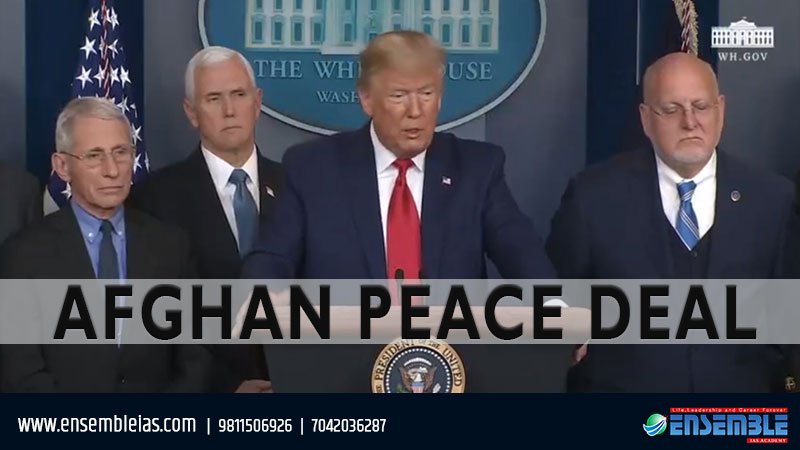The question is whether it is a US-Taliban deal or an Afghan peace deal. We don’t know that yet
On Saturday, February 29, an agreement was signed between the United States (US) and the Taliban in Doha. Widely welcomed as a “peace deal”, it will be claimed by US President Donald Trump as further proof of his uncanny deal-making prowess. But while the deal may well mark the end of the US war in Afghanistan, whether it actually ends conflict in Afghanistan remains an open question.
Negotiations began in September 2018 with the appointment of Ambassador Zalmay Khalilzad to initiate direct talks with the Taliban. It marked a reversal of Trump’s 2017 policy, which was based on breaking the military stalemate in Afghanistan by authorising an additional 5,000 soldiers, giving US forces a freer hand to go after the Taliban, putting Pakistan on notice, and strengthening Afghan capabilities. Since it was soon clear that the policy was not working, and the Taliban insurgency could not be defeated as long as it enjoyed safe havens and secure sanctuaries, the US changed track and sought Pakistan’s help to get the Taliban to the negotiating table.
While the US maintained that Doha talks covered four issues — cessation of hostilities, cutting ties with terrorist organisations such as al-Qaeda, an intra-Afghan peace dialogue, and finally, US troop withdrawal — the Taliban made it clear that its priority was the last issue. It rejected the idea of a ceasefire, and any talks with the Afghan government, describing it as a puppet regime, lacking legitimacy. The Taliban provided some assurances on the second issue, but focused on a firm date for US troop withdrawal.
A deal was ready to be signed on September 8, with a Taliban delegation scheduled to travel to Camp David, but was stalled because of the death of a US soldier in a car bomb attack. Trump also wanted to avoid the negative optics of welcoming a Taliban delegation to Camp David during the week that marks the 9/11 attacks anniversary.
Within a month, talks were revived. The US demanded a ceasefire for a month as a sign of the Taliban’s commitment, but the Taliban demurred. The Taliban felt that too long a ceasefire would make it difficult for it to regroup its fighters once they returned to their villages. Eventually, the US settled for “significant reduction in violence” for a week. The week-long period began in the early hours of February 22, setting the stage for the Doha signing.
The deal provides a timetable for reducing the US troops from 14,000 to 8,600, within 135 days, and the kick-starting of the intra-Afghan peace talks. It is unclear if there is a date for the complete withdrawal of US troops or for concluding the intra-Afghan dialogue, or how long the truce will hold. What is clear is that the US war in Afghanistan will come to an end, allowing Trump to deliver on his promise of bringing the soldiers home in his re-election year.
Around 50 years ago, the US pursued a similar strategy in Vietnam. President Richard Nixon had taken over in 1969, when the US troop presence in Vietnam was over half a million. It was clear that a military solution was not possible. During his secret visit to Beijing in July 1971, Nixon’s National Security Adviser, Henry Kissinger told Chinese Premier Zhou Enlai that the US would agree to a complete withdrawal of troops in return for Hanoi’s releasing the US prisoners of war (POWs) and a ceasefire for “a decent interval, say 18 months or more, before a Communist takeover in Vietnam” . He assured Zhou that if the Saigon government was overthrown following “a decent interval”, the US would not intervene. Neither the US public nor the South Vietnamese were privy to this exchange.
And this is exactly how it unfolded. Nixon visited China in February 1972, describing it as a visit to bring about “a lasting peace in the world”, and won his re-election handsomely in November 1972, promising that “peace was at hand”. In January 1973, the Paris Peace Accord was signed, ending the direct US military involvement and withdrawal, release of POWs, ceasefire and a reunification through peaceful means. Full scale fighting erupted before the end of 1973. South Vietnam lost another 80,000 soldiers till April 30, 1975 when Saigon finally fell. The US did not intervene as its war had been over two years earlier. Kissinger was awarded the Nobel Peace Prize in 1973. Nixon resigned in 1974, facing impeachment in the Watergate scandal.
Many things have changed since, but the US still cannot be seen to be losing the war in a re-election year, and so the US withdrawal needs repackaging as a peace process for Afghanistan.
The problem is that nobody really knows what the Taliban wants and reconciling an emirate- and Shariat-based system with the existing constitution is not easy. How would Taliban fighters be demobilised? How would an amnesty and reintegration package be worked out and who pays? Will an early US withdrawal encourage the Taliban to improve their bargaining position on the battlefield? Are the major powers only “facilitators” or are they collectively prepared to act as “guarantors”?
Addressing these questions is necessary for a good deal, but if the search is only for “a decent interval”, the Taliban, who have waited two decades, can also wait out “a decent interval”.
Rakesh Sood is a former diplomat and currently distinguished fellow, Observer Research Foundation
The views expressed are personal
Source: Hindustan Times | Written by Rakesh Sood
For more details : Ensemble IAS Academy Call Us : +91 98115 06926, +91 7042036287
Email: ensembleias@gmail.com Visit us:- https://ensembleias.com/
#india #prime_minister #narendra_modi #policy #blog #current_affairs #daily_updates #trump #USA #afganusdeal #Afghan #peace #deal US_Taliban #deal #peace_talks #Vietnam_strategy #editorial #geographyoptional #upsc2020 #ias #k_siddharthasir #ensembleiasacademy
